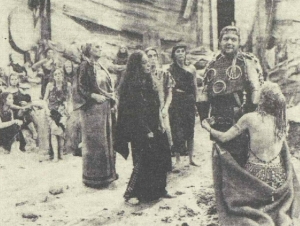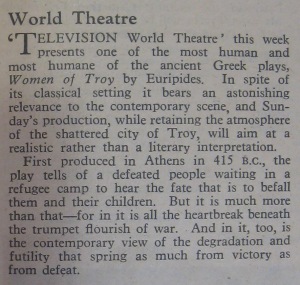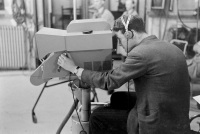In my recent post Greeks on screen, I offered a preliminary survey of productions of Greek drama on British television. Today I would like to build on that by looking in more detail at the first well documented production―the 1958 BBC production of Women of Troy, the harrowing tragedy by Euripides that follows the fates of the women after Troy has been sacked and their husbands killed.
Women of Troy was broadcast as part of a Television World Theatre series alongside plays such as Henry V and The Cherry Orchard. The producers were Casper Wrede and Michael Elliott, both of whom also directed plays for the stage (and who, with others, went on to found what became the Royal Exchange Theatre Company in Manchester). Click on the first image for full cast and credits.
Troy in the public imagination in the late 1950s
Troy had been alive in other cultural forms in the months before transmission. In 1957, Methuen published Eva Hemmer Hansen’s Scandal of Troy, a translation of her Danish novel based on Homer’s Iliad, and Collins published Ivor Brown’s Dark Ladies which offered essays on Helen of Troy, Cleopatra, and others. On ancient Greece in the public imagination at this time, Mary Crozier (in a review of children’s literature such as the Puffin books Tales of the Greek Heroes and The Tale of Troy) wrote:
To-day the latest thing―television―has stirred up a fresh enthusiasm with its pictures of the Hellenic cruises: sunlit Delos, walled Mycenae, the vast theatre at Epidaurus, appearing on our little screens in built-up cities. (Mary Crozier, ‘Children’s Books for Christmas: Encountering the Greeks’, The Manchester Guardian, 5 December 1958, p. 7)
It is striking that around the time of the 1958 Women of Troy, there do not seem to have been many stage productions of Euripides’ once popular tragedy. There had been two in London in 1955 (at the Unity Theatre and the St Pancras Drama Festival), but no high-profile productions to rival those of Sybil Thorndike earlier in the century (pictured). In fact, the major recent productions had been broadcast to large audiences on BBC Radio―with, notably, Thorndike reprising her stage role of Hecuba. In 1946, Val Gielgud produced a timely radio production of the play using the translation of Gilbert Murray. This, too, had been broadcast as part of a World Theatre series, and it reached a massive audience on the Home Service. Thorndike again appeared as Hecuba in a further radio production by Raymond Raikes in 1952. (Incidentally, the image used to accompany the 1958 television listing in the Radio Times―see the first image above―was that first used to illustrate the RT listing for an even earlier radio production in 1937 starring Lillah McCarthy as Hecuba.)

Helen implores Menelaus, with Hecuba and others looking on (image in The Listener, 13 Jan. 1958, p. 134)
The 1958 television production
Perhaps it is to be expected that, with Thorndike so strongly associated with the role of Hecuba on both stage and radio, reviewers appeared distinctly underwhelmed by Catherine Lacey’s portrayal of the Trojan queen in the 1958 television production. Maurice Richardson in The Observer, referring to the Thorndike precedent (as do other reviews, including Ivor Brown in The Listener), was ‘not quite as moved […] as I ought to have been’ and The Times considered that she ‘seemed to be experiencing nothing worse than a bad cold’ (The Observer, 19 January 1958, p. 14; The Times, 13 January 1958, p. 3).
Underwhelmed also describes most reviews of the performances of other actors, but these critical judgements seem to go hand in hand with assessments of Kenneth Cavander’s translation of the Greek play (which Cavander and Wrede had together adapted for television), especially in contrast to the earlier, more poetic and popular model of Murray: it ‘had hardly a note of poetry in it. The addict of the translations of Gilbert Murray might well wonder how an attempt to put across The Trojan Women [sic] without poetry could possibly succeed’ (The Manchester Guardian, 13 January 1958, p. 5).
The production notably opened with a ‘plain, straight verbal announcement of the play’ which was heard at the same time as were shown captions paraphrased from the Preface to Winston Churchill’s recently published A History of the English-Speaking Peoples (1956-58): for example, ‘Every nation has its own tale to tell’ and ‘Knowledge of the trials and struggles of the past is necessary to all who would comprehend the perils that confront us today’. (Churchill had declined an invitation to read out the quotations himself.) These captions were followed by another setting the time, place, and immediate scene.
Clearly, as the image published in The Listener (see above), reviews, and internal memos attest, the set was designed to look like a refugee camp, the purpose of which was to set forth ‘the contemporary view of the degradation and futility that spring as much from victory as from defeat’ (Radio Times, 10 January 1958, p. 5). In fact, to underscore this setting, the production was preceded by extracts from films showing crowds of refugees, burning cities, and even the explosion of an atom bomb―suggestive of the perceived threat, or fear, of nuclear war at this time.
Here [the camera] slowly passed through the fallen columns and over mounds of rubble, picking out clusters of women prone like insects among the ruins, before coming to rest on the prostrate figure of Hecuba. (The Times, 13 January 1958, p. 3)
We glean from internal memos in the production file at the BBC Written Archives Centre (WAC) that the set (which was extensive, requiring the use of the Big Bill Transatlantic Crane for camera one) included features such as a stream, gas fires, and kerosene flame torches. Properties included a leopardskin, 3lb lentils, six gourd bowls, primitive pots, bunches of dates, fish and animal bones, palace spoils (thrones, statues, etc.), a bale of straw, burnt paper ash, laurels, hydrangeas, rhododendrons, boulders, peat, sawdust, fresh leaves, prickly pear plants, two large agaves, and four live oak saplings. Such details, alongside the single image reproduced in The Listener (above), suggest what visual stimuli were offered to the viewer.
(A fifteen-minute excerpt, from half an hour into the production; is said to have been recorded for the BBC archive; I am waiting with bated breath to learn whether it still exists, and if it does I’ll note my impressions of it in a second part to this post.)
Audience
Two months before Women of Troy was broadcast, Michael Elliott had written a memo to the Head of the Television Department which tells us something about the hoped-for audience for this production:
As you know we were from the start most keen that we should avoid giving the impression that this was a production by intellectuals of an intellectual piece and I think it particularly important now that it forms part of a ‘highbrow’ series that we should emphasise that its importance will be as a television programme and as a point of contact between the mass audience and great theatre. (Typescript memo from Michael Elliott to H.D.Tel., 8 November 1957, in BBC WAC T5/2438/1)
There is evidence that despite worries over the ‘highbrow’ label, a range of viewers did find the production engaging. Read the following fascinating account from a female patient in the women’s ward of a London hospital:
As even What’s My Line? is dismissed by ward opinion as too intellectual, there appeared to be no hope at all of my being able to see this play. By accident, however, the TV set was left on following an ice show [an excerpt from Winter Wonderland] and the play began. Every moment I expected someone to express disapproval or turn it off. No one did. I think it was the documentary type of opening that aroused interest at first; but, as the play unfolded, attention was gripped and held and the fate of the Trojan women was closely followed to the end. These patients had heard of neither Euripides nor Troy […] They took Women of Troy as a straight play and were impressed by it. (‘Patient’, ‘Letters to the Editor: Women of Troy’, The Observer, 2 February 1958, p. 17)
In contrast, a relatively high number of telephone calls were made to the BBC within twenty-four hours of the broadcast (as Billy Smart notes in his PhD thesis ‘Old Wine in New Bottles―Adaptation of Classic Theatrical Plays on BBC Television 1957-1985’, Royal Holloway, 2010). Many of these eighteen or so callers rang in to complain that the subject of the play was ‘too horrifying and depressing’, echoing The Guardian writer who found it ‘the most unsettling experience’ of his last six years of theatre-going and television-watching (see image). One Mr Riddle of London E18 had a wider point to make in his phone call: he considered that the BBC was ‘ramming one man’s raving conception of culture down the throats of the general public’ (typescript memo from Etain Boffey to H.D.Tel, 14 January 1958 in BBC WAC T5/2438/1).
Although these eighteen are a tiny fraction of the approximate, astonishing figure of five million viewers, they were clearly representative. (Five million was about average for the plays in the Television World Theatre series, but Gogol’s The Government Inspector achieved nine and a half million: Anon., ‘Cost to BBC of Competitive Television’, The Times, 13 March 1958, p. 14). We learn quite a lot from the Audience Research Report on this production (BBC WAC VR/58/32): the ‘reaction index’, calculated from the questionnaires completed by 220 respondents on the BBC’s Viewing Panel, was forty-two―well below the annual average of sixty-eight. The report offers more detail: ‘A large number of viewers in the sample spoke as if Women of Troy had been some nerve-wracking trial inflicted upon them by the BBC―to their manifest discomfort and distaste’. Such viewers described the production as a ‘diatribe of woe’ and ‘abysmally depressing’. It is clear that for many this audiovisual encounter with the Greeks (to borrow Mary Crozier’s term) was simply too potent for a Sunday evening’s entertainment.
Yet, a quarter of the sample reported being impressed and moved by the production; many of these, the report states, were admittedly those ‘who could claim some previous knowledge of the play’. Of these, one viewer described as a ‘Teacher’ was alert to the modern resonances in this television production of the ancient play:
The most striking point about this play was its realism. It might have happened yesterday―it could happen again tomorrow. These women belonged not only to the Greek slave ships, but to the displaced persons’ camps, the Belsens, the gas chambers of the twentieth century.
Ivor Brown in The Listener considered that ‘in presenting Greek tragedy, the prosaic and the photographic will not do poetry’s work: the majesterial outcry dwindles to a grumble and a whimper. But, if the arrow fell to earth, the BBC did well to attempt such exalted archery’ (Ivor Brown, ‘Drama: Women,Trojan and Scottish’, The Listener, 16 January 1958, p. 134).
Discussing the impact and importance of the Television World Theatre series in general, Richardson in The Observer appeals to the potential audience for ‘classic’ theatre plays on television thus:
This is not just a question of: […] Does the Admass prefer Ben Travers to Euripides? It is a question of whether you think there is any future for the serious drama on television. If you do, you must be prepared to put up with some plucky tries that do not quite come off. […] So, unless you are on the side of the dark forces, down with your knitting, put away that paper-backed Dornford Yates and give all your attention to the screen. It is most important that this experiment should succeed. (The Observer, 19 January 1958, p. 14)





Discussion
Trackbacks/Pingbacks
Pingback: Greek plays: Women of Troy (BBC, 1958) | Athenian Drama - 16 September 2012
Pingback: Television World Theatre: The Life of Henry the Fifth (BBC, 1957) | SCREEN PLAYS - 11 June 2013
Pingback: From Television World Theatre to the BBC Shakespeare: The fluctuating status of the classic play on BBC Television 1957-1985 | Forgotten Television Drama - 1 August 2014